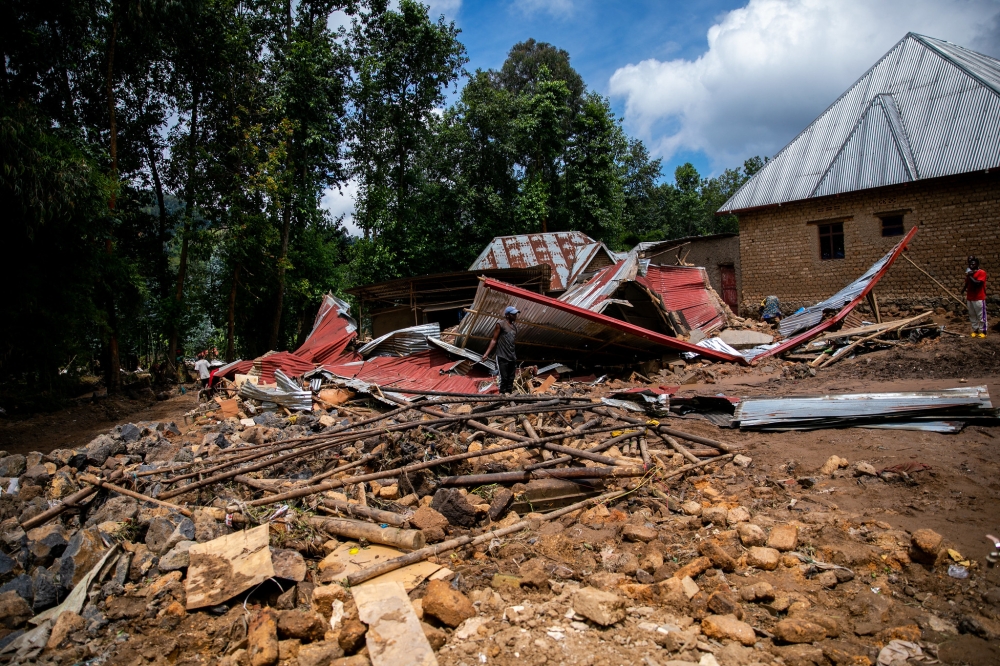Rubavu district has taken a significant step toward assisting families affected by the recent flooding of the River Sebeya by designating three sites encompassing 16 hectares for the construction of model villages. This initiative aims to provide accommodation to those displaced by the floods.
In response to concerns about land ownership, Rubavu authorities have reassured residents that the allocated land will remain their property, albeit with a specific emphasis on its use solely for agricultural and environmental conservation activities.
With the closure of temporary accommodation facilities by the government, the immediate focus now shifts towards relocating and rehousing individuals who were displaced by the River Sebeya flooding, as well as those residing in high-risk areas.
 Acting mayor Deogratias Nzabonimba has reported that a total of 1,564 houses in the sectors of Nyamyumba, Ngerero, Kanama, and Nyundo were damaged due to the floods. Among these, 855 houses were entirely destroyed by flooding and landslides, while 719 sustained severe damage rendering them uninhabitable. An additional 287 houses are also situated in high-risk zones as a consequence of the recent disasters.
Acting mayor Deogratias Nzabonimba has reported that a total of 1,564 houses in the sectors of Nyamyumba, Ngerero, Kanama, and Nyundo were damaged due to the floods. Among these, 855 houses were entirely destroyed by flooding and landslides, while 719 sustained severe damage rendering them uninhabitable. An additional 287 houses are also situated in high-risk zones as a consequence of the recent disasters.
To mitigate the risk of collapse, residents will be relocated from the land along River Sebeya. It is important to note that despite the relocation, the land will remain the property of the residents and can be utilized for various activities after leaving a buffer zone, as confirmed by Nzabonimba.
Identified as suitable for the construction of model villages, the three designated sites will provide new homes for 870 families. Homeowners whose houses were destroyed will receive rent fees while awaiting relocation. However, there are currently no plans to relocate major infrastructure impacted by the river, including the Gihira water treatment plant, Gisenyi hydropower plant, schools, and the Pfunda tea factory.
Gilbert Baryaningwe, a 73-year-old resident who has previously experienced floods caused by the River Sebeya, described the recent flooding as the most severe to date. Urging the government to invest in flood control infrastructure, Baryaningwe emphasized the need for the construction of additional retaining walls.
The flooding in the affected districts of the western province originates from the River Sebeya catchments located in Rubavu, Rutsiro, Nyabihu, and Ngororero districts. Ongoing efforts to address the sustained flooding include the construction of two dams along the Sebeya River, with a budget allocation of Rwf7.5 billion.
The Sebeya Catchment Management Plan, spanning from 2018 to 2024, underscores the necessity of landscape restoration in approximately 18,000 hectares at risk of soil erosion within the Sebeya River catchment area. This measure aims to minimize economic losses for off-farm businesses located near the river.
To ensure sustainable livelihoods, Baryaningwe highlighted the importance of utilizing the land even after relocation from the riverbank. He suggested the cultivation of cash crops and other agricultural products as a means to address food insecurity.
Despite residing 700 meters away from the River Sebeya, Mohamed Icyizanye, a 43-year-old resident, lost two houses to the disasters, with another suffering damage. Icyizanye emphasized the urgent need for additional retaining walls to control future flooding incidents.
The displaced families will be relocated to three sites: two in the Rugerero sector and one in the Nyamyumba sector. Shakila Nyirarukundo, another resident, has suggested the potential benefits of rehousing families near their original land.
Additionally, the National Identification Agency (NIDA) has mobilized a workforce to assist residents who lost their land titles during the devastating floods. Nyirarukundo stressed the importance of resilient agricultural planning to ensure continued land cultivation in the model villages.
To address the extensive housing needs resulting from the floods, the government estimates a requirement of approximately Rwf30 billion to construct 3,006 houses across Rubavu, Ngororero, Nyabihu, Rutsiro, Karongi, Gakenke, Burera, Musanze, and Nyamagabe districts in the Western, Northern, and Southern provinces.
